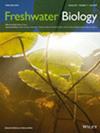Competitive Outcomes Between Floating-Leaved and Submerged Plants Under Eutrophication Depend on Growth Form
IF 2.8
2区 生物学
Q2 ECOLOGY
引用次数: 0
Abstract
- The niches of floating-leaved plants partially overlap with those of submerged plants, leading to widespread competition between the two in freshwater ecosystems. Therefore, one of the biggest challenges for submerged plants is coexisting with floating-leaved plants. However, the mechanisms of coexistence between floating-leaved plants of varying densities and different growth forms of submerged plants under eutrophic conditions remain unclear.
- Here, we conducted a mesocosm experiment to study the combined effects of different densities and eutrophication levels of a common floating-leaved plant (Nymphoides peltata) on three growth forms of submerged plants (bottom-dwelling Vallisneria natans, erect Myriophyllum aquaticum and canopy-forming Myriophyllum spicatum).
- We found that intermediate and high densities (9 and 18 plants) of N. peltata significantly reduced the total biomass and leaf chlorophyll content of submerged plants and had a greater impact on the morphological traits of V. natans and M. spicatum. In contrast, its effects on M. aquaticum were relatively minor, causing only slight reductions in ramet number and plant height. Elevated nutrient levels alleviated the competitive pressure of intermediate density N. peltata on submerged plants but were more favourable to M. spicatum and M. aquaticum. Submerged plants of different growth forms exhibited species-specific responses to this. V. natans responded by increasing plant height and allocating more biomass to the roots, while M. spicatum responded by producing more ramets and having a lower root/shoot ratio.
- The combined effect of density and nutrient level had the greatest impact on the organ nutrient content of the erect M. aquaticum. Furthermore, increased floating-leaved plant density and higher levels of eutrophication were most detrimental to the growth of the bottom-dwelling V. natans.
- Our study suggests that under eutrophic conditions, the coexistence pattern between floating-leaved and submerged plants will change, strengthening the dominance of floating-leaved plants and presenting greater challenges for submerged plants.
富营养化条件下浮叶植物与沉叶植物的竞争结果取决于生长形式
浮叶植物的生态位与沉叶植物的生态位部分重叠,导致两者在淡水生态系统中广泛竞争。因此,水下植物面临的最大挑战之一是如何与浮叶植物共存。然而,在富营养化条件下,不同密度的浮叶植物与不同生长形式的沉水植物共存的机制尚不清楚。本研究通过中生态实验,研究了不同密度和富营养化水平对三种水下植物(底栖水草、直立水草和冠生水草)生长的综合影响。结果表明,中、高密度(9株和18株)的泥炭草显著降低了被淹植物的总生物量和叶片叶绿素含量,并对泥炭草和细棘草的形态性状有较大影响。而对水杨的影响相对较小,仅引起分株数和株高的轻微降低。升高的养分水平减轻了中密度褐藻对沉水植物的竞争压力,但对棘足鼠和水草鼠更有利。不同生长形式的沉水植物对此表现出物种特异性反应。柽柳以增加株高和向根系分配更多生物量为响应方式,而刺柳以产生更多分株和较低的根冠比为响应方式。密度和营养水平的综合作用对直立水杨各器官养分含量的影响最大。浮叶植物密度的增加和富营养化程度的提高对底栖水草的生长最为不利。我们的研究表明,在富营养化条件下,浮叶植物与沉水植物的共存格局将发生变化,浮叶植物的优势地位增强,沉水植物面临更大的挑战。
本文章由计算机程序翻译,如有差异,请以英文原文为准。
求助全文
约1分钟内获得全文
求助全文
来源期刊

Freshwater Biology
生物-海洋与淡水生物学
CiteScore
5.90
自引率
3.70%
发文量
162
审稿时长
2 months
期刊介绍:
Freshwater Biology publishes papers on all aspects of the ecology of inland waters, including rivers and lakes, ground waters, flood plains and other freshwater wetlands. We include studies of micro-organisms, algae, macrophytes, invertebrates, fish and other vertebrates, as well as those concerning whole systems and related physical and chemical aspects of the environment, provided that they have clear biological relevance.
Studies may focus at any level in the ecological hierarchy from physiological ecology and animal behaviour, through population dynamics and evolutionary genetics, to community interactions, biogeography and ecosystem functioning. They may also be at any scale: from microhabitat to landscape, and continental to global. Preference is given to research, whether meta-analytical, experimental, theoretical or descriptive, highlighting causal (ecological) mechanisms from which clearly stated hypotheses are derived. Manuscripts with an experimental or conceptual flavour are particularly welcome, as are those or which integrate laboratory and field work, and studies from less well researched areas of the world. Priority is given to submissions that are likely to interest a wide range of readers.
We encourage submission of papers well grounded in ecological theory that deal with issues related to the conservation and management of inland waters. Papers interpreting fundamental research in a way that makes clear its applied, strategic or socio-economic relevance are also welcome.
Review articles (FRESHWATER BIOLOGY REVIEWS) and discussion papers (OPINION) are also invited: these enable authors to publish high-quality material outside the constraints of standard research papers.
 求助内容:
求助内容: 应助结果提醒方式:
应助结果提醒方式:


